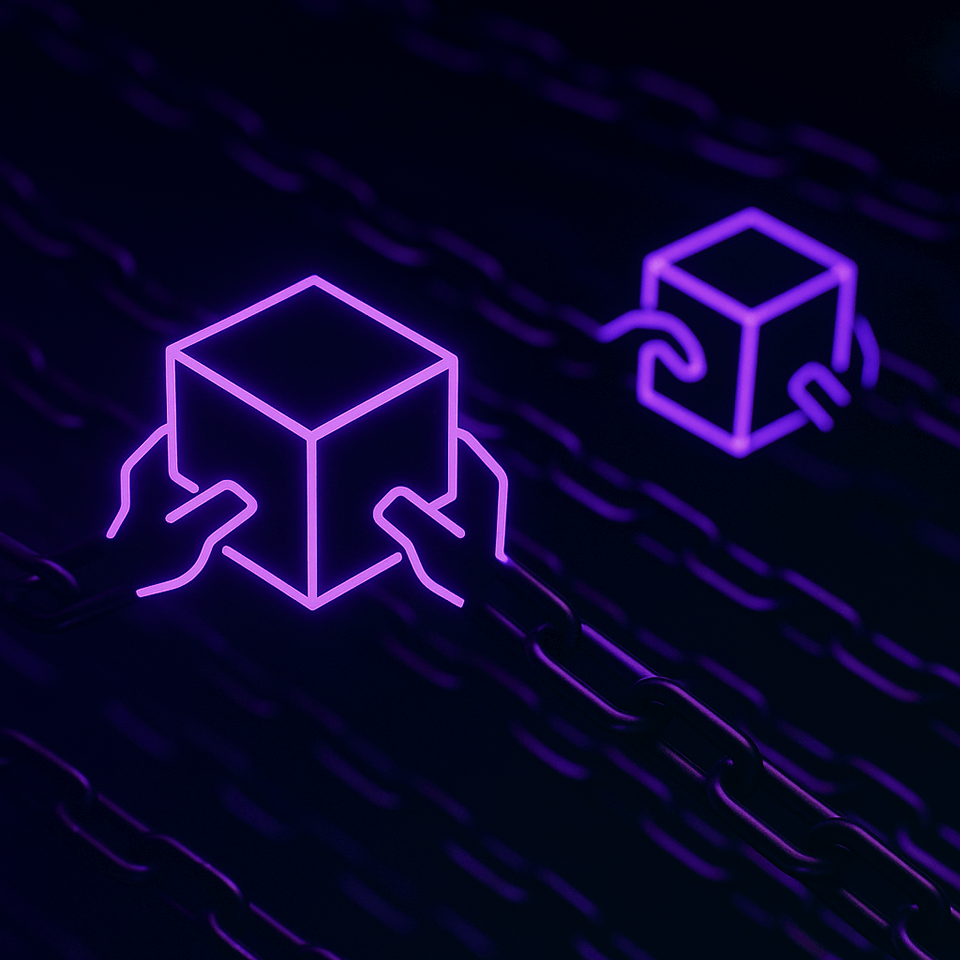The blockchain landscape has evolved from a single-chain paradigm to a diverse multi-chain ecosystem, with over 6,500 blockchain projects operating independently across different protocols, consensus mechanisms, and technological frameworks. This fragmentation has created what experts describe as “digital islands” where valuable assets, data, and applications remain trapped within isolated networks, unable to communicate or interact with each other. Blockchain interoperability has emerged as the critical infrastructure needed to unlock the full potential of decentralized technology, enabling seamless communication, asset transfers, and smart contract execution across disparate blockchain networks.
The market validation for interoperability solutions is compelling. The global blockchain interoperability market, valued at approximately $375 million to $1.2 billion in 2024, is projected to reach between $2.8 billion and $15.7 billion by 2032-2033, representing compound annual growth rates of 27-30%. This explosive growth reflects not just investor confidence but the fundamental necessity of connecting blockchain networks to create a unified, accessible Web3 ecosystem that can serve mainstream adoption.
Blockchain Interoperability Market Growth Projections (2023-2033): Conservative vs Optimistic Scenarios
The Multi-Chain Reality and Interoperability Imperative
The transition from a single-chain to multi-chain world was inevitable due to the inherent limitations of individual blockchain networks. No single blockchain can optimize for all desired characteristics simultaneously—speed, security, decentralization, cost-effectiveness, and specialized functionality represent trade-offs that different networks address uniquely. Ethereum excels in security and developer tooling but faces scalability challenges, while Solana prioritizes high throughput but may compromise on decentralization. Cosmos focuses on sovereignty and interoperability, while Polkadot emphasizes shared security and cross-chain messaging.
Blockchain interoperability solutions and key platforms highlighting their unique features in connecting multi-chain ecosystems.
This specialization has created a fragmented ecosystem where users must navigate multiple wallets, interfaces, and protocols to access different blockchain services. The result is a poor user experience that significantly barriers mass adoption, forcing users to maintain separate accounts, understand different tokenomics, and execute complex bridging procedures to move assets between networks. The fragmentation also leads to liquidity dispersion, where capital remains locked within specific ecosystems, reducing overall market efficiency and limiting the composability benefits that make DeFi applications powerful.
Blockchain interoperability addresses these challenges by enabling seamless communication between networks, allowing them to share data, transfer assets, and execute smart contracts across chains without requiring users to understand the underlying complexity. This creates what industry leaders envision as an “Internet of Blockchains”—a connected ecosystem where specialized networks collaborate to provide users with optimal experiences regardless of which underlying chain hosts specific applications or assets.
The business case for interoperability extends beyond user experience improvements. Enterprise adoption of blockchain technology increasingly requires integration with existing systems and the ability to leverage multiple blockchain networks for different use cases. A supply chain application might utilize Ethereum for smart contracts, Polygon for cost-effective transactions, and a private consortium blockchain for sensitive data, necessitating seamless interoperability between all three networks.
Technical Foundations of Interoperability Solutions
Modern interoperability solutions employ diverse architectural approaches, each with distinct trade-offs regarding security, scalability, and decentralization. Cross-chain bridges represent the most common approach, using smart contracts to lock assets on source chains while minting equivalent tokens on destination chains. This lock-and-mint mechanism enables token transfers but introduces centralization risks and security vulnerabilities, as demonstrated by over $2.8 billion in bridge exploits since 2021.
Three main cross-chain bridge architectures for NFT smart contracts: Burn-and-Mint, Lock-and-Mint, and Lock-and-Unlock methods illustrating blockchain interoperability.
Atomic swaps provide a more decentralized alternative, enabling direct peer-to-peer cryptocurrency exchanges between different blockchains without intermediaries. Using hashed timelock contracts (HTLCs), atomic swaps ensure transactions either complete fully or fail entirely, eliminating counterparty risk. However, they’re limited to simple token swaps and lack the functionality needed for complex cross-chain applications.
Relay chain architectures like Polkadot’s represent sophisticated interoperability solutions where a central relay chain provides shared security and messaging capabilities for connected parachains. This approach enables true cross-chain smart contract execution and communication while maintaining high security standards, though it requires networks to integrate within the specific ecosystem framework.
Diagram illustrating Polkadot’s multi-chain architecture including relay chain, parachains, parathreads, and bridges for blockchain interoperability.
Hub-and-spoke models exemplified by Cosmos and Axelar create central hubs that facilitate communication between connected networks through standardized protocols like Inter-Blockchain Communication (IBC). This approach offers superior scalability compared to point-to-point connections, as adding new networks requires only hub integration rather than bilateral connections with every existing chain.
Oracle-based solutions like Chainlink’s Cross-Chain Interoperability Protocol (CCIP) provide secure messaging and token transfer capabilities using decentralized oracle networks to verify cross-chain events. These solutions leverage existing oracle infrastructure to provide interoperability services while maintaining high security standards through multiple verification layers.
Major Interoperability Protocols and Competitive Landscape
The interoperability landscape features several leading protocols, each pursuing different technical approaches and market strategies. Axelar Network has emerged as a dominant hub-and-spoke solution, connecting over 60 blockchains including Ethereum, Solana, Avalanche, and various Cosmos-based chains. With over $8.66 billion in processed cross-chain transfers and 1.85 million transactions, Axelar demonstrates significant market traction through its General Message Passing (GMP) system that enables arbitrary cross-chain interactions beyond simple token transfers.
Major Blockchain Interoperability Protocols Comparison: Network Coverage vs Transaction Volume (2025)
Wormhole leads in transaction volume, having facilitated over $58.9 billion in cross-chain transfers through more than 1 billion messages. Supporting 30+ blockchain networks including Ethereum, Solana, and emerging Layer-1 platforms, Wormhole uses a guardian network model to monitor and verify cross-chain activity. Despite experiencing a significant security incident in 2022 that resulted in $325 million losses, the protocol has since strengthened its security practices and maintains its position as a leading interoperability solution.
LayerZero takes a unique approach using ultra-light nodes (ULNs) that combine on-chain light clients with off-chain oracles and relayers to verify cross-chain transactions. With over 30 supported networks and $6.4 billion in processed volume, LayerZero focuses on message passing rather than asset bridging, providing infrastructure for developers to build cross-chain applications. The protocol’s emphasis on developer tools and APIs has attracted significant adoption among DeFi projects building multi-chain applications.
Polkadot represents the most technically sophisticated interoperability solution, using its relay chain to provide shared security for connected parachains. With projected capability to support 100+ parachains and existing infrastructure handling complex cross-chain message passing through XCM (Cross-Consensus Messaging), Polkadot offers true multi-chain scalability. The platform’s substrate framework enables developers to build custom blockchains with built-in interoperability, positioning it as infrastructure for the multi-chain future.
Cosmos pioneered the hub-and-spoke interoperability model with its IBC protocol now connecting over 115 networks and processing millions of transactions monthly. The Cosmos ecosystem demonstrates the power of modular blockchain architecture, where sovereign chains maintain independence while benefiting from shared interoperability standards. Recent developments include the mBridge project collaboration with central banks to explore CBDC interoperability, highlighting enterprise adoption potential.
Cross-Chain DeFi Applications and Use Cases
Decentralized Finance represents the most mature use case for blockchain interoperability, with cross-chain applications generating significant value and demonstrating real-world utility. Multi-chain DEXs like Uniswap now operate across Ethereum, Polygon, Arbitrum, and other networks, allowing users to access optimal liquidity and trading conditions regardless of their preferred blockchain. These platforms aggregate liquidity from multiple chains, reducing slippage and improving price discovery while offering users flexibility in choosing networks based on transaction costs and speed preferences.
Cross-chain lending protocols enable users to deposit assets on one blockchain while borrowing against them on another, dramatically expanding capital efficiency. Platforms like Aave operate across multiple networks, allowing users to optimize their positions based on varying interest rates, collateral requirements, and token availability across chains. This cross-chain approach increases liquidity utilization and provides users with more sophisticated financial strategies previously impossible within single-chain constraints.
Yield farming optimization represents another compelling use case, where users can automatically move assets between different chains to capture the highest available yields. Automated vaults aggregate opportunities across multiple blockchain networks, rebalancing positions based on changing market conditions and yield rates. This approach maximizes returns while reducing the complexity of manually managing positions across multiple chains.
Cross-chain NFT marketplaces enable creators and collectors to interact with digital assets regardless of their originating blockchain. Platforms like OpenSea now support Ethereum, Polygon, and other networks, allowing users to mint NFTs on cost-effective chains while accessing broader markets. Interoperable NFTs retain functionality across ecosystems, expanding use cases in gaming, digital art, and virtual worlds.
Gaming applications increasingly leverage multi-chain architectures to optimize different aspects of gameplay. Games might use Ethereum for valuable in-game assets that require maximum security, Polygon for frequent micro-transactions, and specialized gaming chains for real-time interactions. Cross-chain interoperability enables seamless asset movement and unified player experiences across these different network layers.
Security Challenges and Risk Management
Blockchain interoperability introduces unique security challenges that don’t exist in single-chain environments. Bridge vulnerabilities represent the largest attack vector in the entire crypto ecosystem, with notable exploits including the $624 million Ronin bridge hack and $325 million Wormhole attack. These incidents highlight the inherent risks of cross-chain infrastructure, where complex smart contracts managing large asset pools become high-value targets for sophisticated attackers.
Consensus mechanism incompatibilities create fundamental security challenges when connecting blockchains with different finality characteristics. Networks using probabilistic finality like Bitcoin’s Proof-of-Work may conflict with chains offering immediate deterministic finality, creating opportunities for timing attacks and double-spending exploits. Cross-chain protocols must carefully handle these differences to maintain security across all connected networks.[29][30]
Validator compromise and key management issues pose significant risks to interoperability infrastructure. Many bridge protocols rely on multi-signature schemes or validator networks that, if compromised, can result in total loss of managed assets. The Multichain protocol’s $125 million hack in 2023, potentially related to missing CEO and centralized key management, exemplifies these risks.
Smart contract complexity in cross-chain systems exponentially increases potential attack surfaces. Interoperability protocols must handle multiple blockchain protocols, token standards, and execution environments, creating opportunities for logical flaws and implementation errors. The complexity makes comprehensive security audits more challenging while increasing the likelihood of overlooking critical vulnerabilities.
Cryptographic incompatibilities between different blockchain networks can compromise privacy and security when assets and data move across chains. Networks using different cryptographic standards may expose sensitive information or reduce security guarantees during cross-chain operations, requiring careful handling of cryptographic protocol mismatches.
Risk Mitigation Strategies
Multi-layered security architectures provide the most robust protection against cross-chain attacks. Implementations should include multiple independent validation systems, time-locked transactions for large transfers, and circuit breakers that automatically pause operations when suspicious patterns emerge. These defenses create redundancy that prevents single points of failure from compromising entire systems.
Gradual security rollouts with limited initial value exposure allow protocols to demonstrate security in production environments before scaling to larger transaction volumes. Progressive increases in bridge limits and transaction sizes enable teams to identify and address vulnerabilities while minimizing potential losses from undiscovered exploits.
Formal verification and continuous auditing practices help identify vulnerabilities in complex cross-chain smart contracts before they reach production. Regular security reviews by multiple independent firms, combined with bug bounty programs and community audits, provide comprehensive coverage of potential attack vectors.
Decentralized validator networks reduce centralization risks by distributing control across multiple independent operators. Protocols should implement slashing mechanisms that penalize malicious behavior while ensuring validator sets remain sufficiently decentralized to prevent collusion attacks.
Enterprise Adoption and Institutional Use Cases
Enterprise blockchain adoption increasingly requires interoperability capabilities to integrate with existing systems and leverage multiple blockchain networks for different use cases. Supply chain management represents a leading enterprise application, where companies use multiple blockchains to track products, manage payments, and ensure compliance across different regions and regulatory frameworks. Interoperability enables end-to-end visibility while allowing each network segment to optimize for specific requirements like privacy, throughput, or regulatory compliance.
Financial services institutions are exploring cross-chain solutions for payments, trade finance, and asset management applications. The mBridge project, a collaboration between central banks from Hong Kong, Thailand, the UAE, and China, demonstrates institutional interest in cross-chain CBDC platforms for international payments. Such applications require robust interoperability infrastructure that can handle regulatory compliance, privacy requirements, and integration with traditional financial systems.
Healthcare data sharing benefits significantly from interoperability solutions that enable secure, privacy-preserving data exchange between different healthcare blockchain networks. Hospitals, research institutions, and pharmaceutical companies can collaborate while maintaining data sovereignty and compliance with regulations like HIPAA through selective disclosure and cross-chain privacy-preserving protocols.
Government services and digital identity applications leverage interoperability to create unified citizen experiences across different government agencies and jurisdictions. Citizens can maintain consistent digital identities while accessing services from multiple government blockchain networks, reducing bureaucracy and improving service delivery efficiency.
Technological Innovation and Future Developments
Zero-Knowledge (ZK) technologies are revolutionizing interoperability by enabling privacy-preserving cross-chain interactions with enhanced security guarantees. ZK-based light clients allow one blockchain to verify events on another without requiring full transaction data, reducing costs and improving privacy. Projects like the MAP protocol implement ZK-optimized verification that reduces on-chain costs from O(N²) to O(N) complexity, making large-scale interoperability economically viable.
AI-powered optimization is emerging as a significant trend in cross-chain applications, with artificial intelligence systems automatically routing transactions and managing liquidity across multiple blockchain networks. AI algorithms can analyze real-time network conditions, fee structures, and liquidity availability to optimize user experiences while minimizing costs and execution times.
Chain abstraction represents the next evolution of interoperability, where users interact with blockchain applications without needing to understand or manage the underlying multi-chain complexity. This approach hides technical implementation details behind unified interfaces, making blockchain technology as accessible as traditional internet applications.
Composable applications enable developers to build sophisticated dApps that seamlessly integrate smart contracts and services from multiple blockchain networks. This composability unlocks new possibilities for financial products, gaming experiences, and enterprise applications that leverage the unique strengths of different blockchain ecosystems.
Interchain Security models like those being developed by Cosmos enable smaller blockchain networks to benefit from the security of larger, more established chains. This shared security approach reduces the barriers to launching new blockchain networks while maintaining high security standards through established validator networks.
Market Growth Drivers and Economic Impact
DeFi expansion continues to drive interoperability adoption, with cross-chain protocols now representing 57% of the total interoperability market. The ability to access optimal yields, liquidity, and trading opportunities across multiple blockchain networks has become essential for sophisticated DeFi users, creating sustained demand for robust interoperability infrastructure.
NFT and gaming applications contribute significantly to interoperability growth, with multi-chain NFTs surging 133% since 2022. Gaming applications particularly benefit from multi-chain architectures that can optimize for different aspects of gameplay while maintaining unified player experiences and asset portability.
Regulatory clarity improvements in major markets are enabling broader institutional adoption of interoperability solutions. The European Union’s MiCA regulation and similar frameworks provide the regulatory certainty needed for enterprises to implement cross-chain solutions while ensuring compliance with evolving legal requirements.
Layer 2 scaling integration creates additional demand for interoperability solutions as Ethereum Layer 2 networks like Arbitrum, Polygon, and Optimism require seamless asset movement and unified user experiences. The proliferation of Layer 2 solutions increases the number of networks requiring interconnection, expanding the addressable market for interoperability protocols.
Enterprise blockchain adoption accelerates as organizations recognize the benefits of leveraging multiple blockchain networks for different aspects of their operations. Companies can optimize costs, performance, and regulatory compliance by using specialized networks while maintaining unified workflows through interoperability solutions.
Challenges and Future Outlook
Standardization efforts remain critical for achieving widespread interoperability, as the current landscape features numerous competing protocols with limited compatibility. Industry initiatives to develop common standards and frameworks could accelerate adoption by reducing integration complexity and ensuring compatibility between different interoperability solutions.
Scalability requirements continue to challenge interoperability protocols as transaction volumes and supported networks increase. Solutions must handle growing demand while maintaining security and decentralization, requiring continued innovation in areas like consensus mechanisms, state verification, and cross-chain communication protocols.
Regulatory evolution will significantly impact interoperability development as governments worldwide develop frameworks for cross-border blockchain applications. Protocols must balance innovation with compliance requirements while ensuring they can adapt to changing regulatory landscapes across different jurisdictions.
Security maturation remains essential as the interoperability sector addresses lessons learned from early bridge exploits. Continued investment in security research, formal verification, and risk management practices will determine whether the sector can achieve the reliability needed for mainstream enterprise adoption.
Conclusion
Blockchain interoperability represents the foundational infrastructure necessary to realize the full potential of decentralized technology. As the blockchain ecosystem continues to evolve toward increased specialization and diversity, the ability to seamlessly connect different networks becomes not just advantageous but essential for mainstream adoption and enterprise utility. The projected market growth from $375 million to potentially $15.7 billion by 2033 reflects both the enormous opportunity and critical necessity of interoperability solutions.
The technical progress demonstrated by leading protocols like Axelar, Wormhole, LayerZero, Polkadot, and Cosmos shows that robust interoperability is achievable, though challenges around security, scalability, and standardization remain. The lessons learned from early bridge exploits have driven significant improvements in security practices, while innovations in zero-knowledge technologies, AI optimization, and chain abstraction point toward a future where cross-chain interactions become as seamless as traditional internet communications.
For enterprises, developers, and users, the multi-chain future is not a distant possibility but a current reality. Organizations that embrace interoperability solutions today position themselves to leverage the unique strengths of different blockchain networks while providing unified, efficient experiences for their stakeholders. The convergence of improved security, regulatory clarity, and technological advancement creates an unprecedented opportunity to build the connected blockchain infrastructure that will power the next generation of decentralized applications and services.
The question is no longer whether blockchain networks should interoperate, but how quickly the ecosystem can develop the robust, secure, and user-friendly interoperability infrastructure needed to unlock the transformative potential of a truly connected Web3 ecosystem. The organizations and protocols that successfully navigate this transition will shape the foundation of the decentralized internet for years to come.


